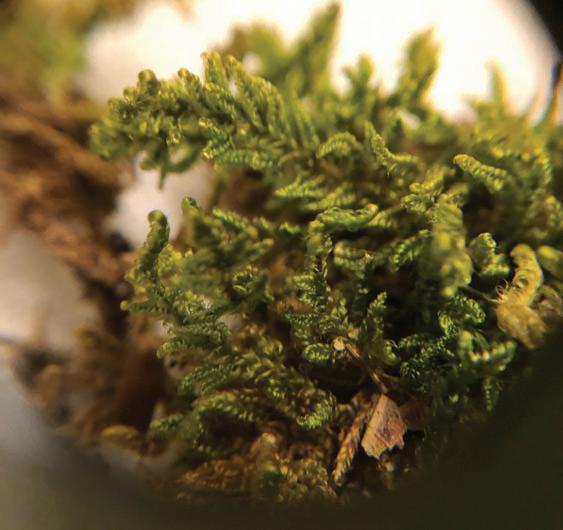3 minute read
3 Dicranum Scoparium Hedw. - Broom Moss............... Family: Dicranaceae

Dicranum Scoparium Hedw. - Broom Moss
Date: January 24, 2021 Loca on: Lenape Woods Nature Preserve, Atlan c Highlands, New Jersey Soil condi ons + habitat: Sandy, coarse, Leaf li er and tree bark. On decaying tree stump. Moist and Shaded. Height & habitat: 1in tall, sec ons depending on tree stump. Wide area. Damp, shaded by above tree canopy. Light and moisture condi ons: dry leaves, moist roots/sand/leaf li er. Eleva on: 260 above sea level
Characteris cs: Leaves: lanceolate, curved, margins en re arranged falcate- secund, spiral phyllotaxy, overlapping, shiny, translucent. No midvein. Color ranging from dark green to light green. Individual tall gametophytes joined together and standing erect at rhizoid. Gametophyte: standing erect, acrocarpous, clumping together Roots: Rhizoma c, a ached to tree bark, decaying trees, rock, gravel and sand Sporophyte: Not present
Iden fi ca on: Specimen appeared to be non-vascular as leaves have no midrib or vasculature. Low lying. Specimen was found in a shaded area of wooded area in clumps on a decaying tree stump among rocks and leaf li er. ‘Botany in a Day’ references spore plants without a vascular system on page 8 as “limited in size, especially common on rocks along babbling brooks where they are above the water, but constantly damp.” (Eipel,2018) as Eipel does not cover these plants, this led to a google search of “bryophytes NJ” which led to a visual key from ‘Morphology of Mosses (Phylum Bryophyta)’ from efl oras no ng the varia ons in leaf morphology. The drawing which most closely matches the specimen shows the dicranum mosses as having falcate-secund leaves.
Further research led to ‘Field Guide to the Moss Genera in New Jersey With Coeffi cient of Conserva on and Indicator Status’. For cross- confi rma on I u lized the key which separated species into keys using three fi eld characteris cs., I noted the specimen had an upright growth form, a costa which extended to the apex, and Leaves that are broader at the base. This led to Key I which noted “Leaf cells smooth, leaves appear shiny due to refl ec on of light” and “Leaves tapering to a long, narrow p, o en curved” (Bowman, 2017) as belonging to the dicranum family. The entry for dicranaceae/dicranum mosses on pg 111 notes similar characteris cs to the entry in efl ora. Erect stems, shiny tu s, lanceolate leaves which are falcate- secund(bowman, 2017). The entry for Dicranum Scoparium Hedw. most closely matches the specimen both visually and based on habitat (mesic woodland) and substrate (decaying stumps and logs) (bowman,2017)
I confi rmed the specimen characteris cs on the USDA forestry website and referenced the classifi ca on report.
A Botanists Vocabulary was referenced to be er understand all terms found in ‘Botany in a Day’, ‘Morphology of Mosses (Phylum Bryophyta)’, ‘Field Guide to the Moss Genera in New Jersey With Coeffi cient of Conserva on and Indicator Status’ and on the USDA database. (Pell & Angell, 2016)
Iden ty: Kingdom: Plantae – Plants Division: Bryophyta – Mosses Subdivision: Musci Class: Bryopsida – True mosses Subclass: Bryidae Order: Dicranales Family: Dicranaceae Genus: Dicranum Hedw. – dicranum moss Species: Dicranum scoparium Hedw. – dicranum moss (USDA,2021)








